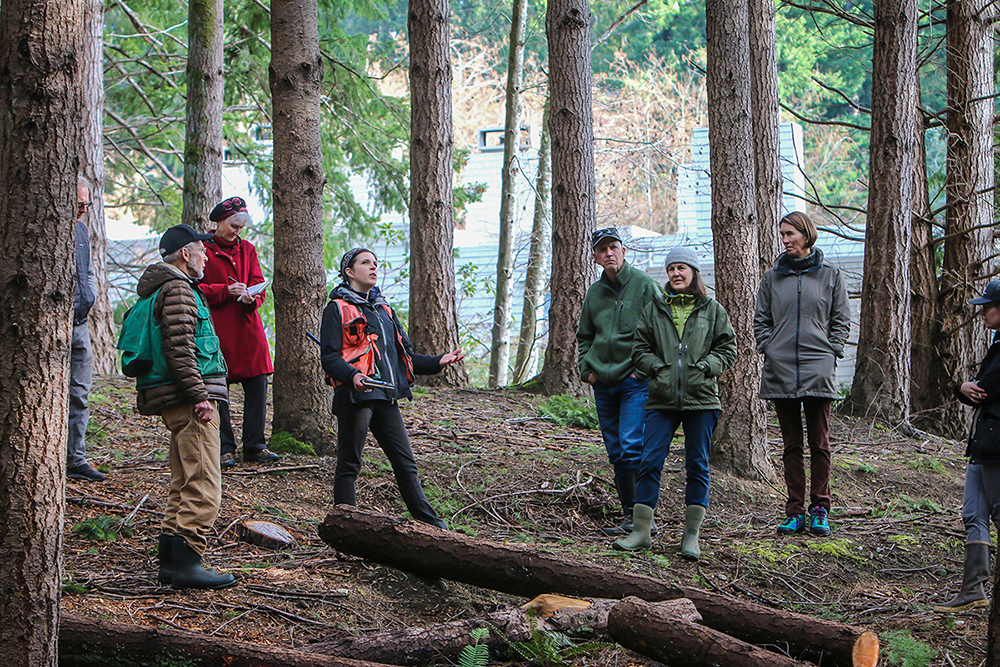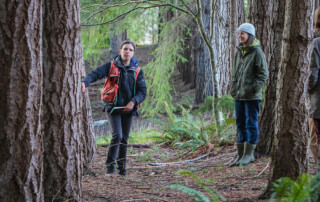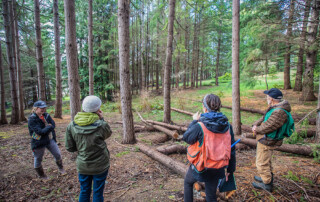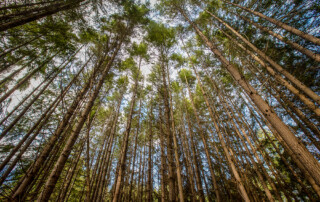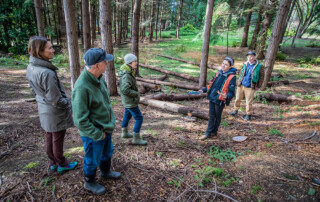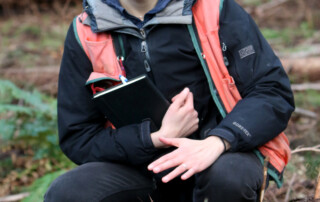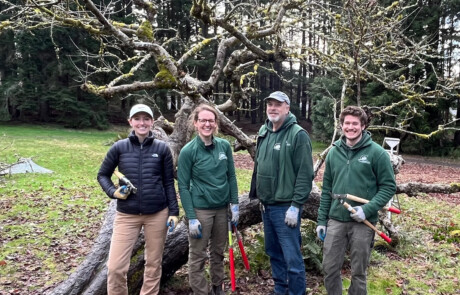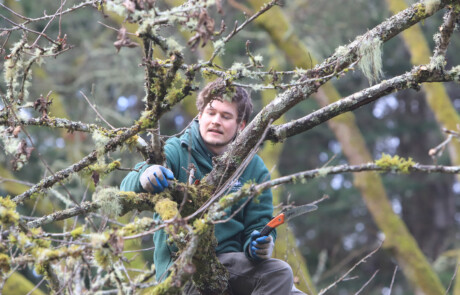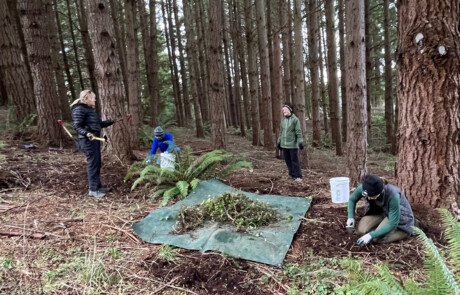For a forester, a walk in the woods is never just that.
When she first stepped into Moritani Preserve, Malloree Weinheimer – atypical of her profession, perhaps, with a background in art history – could see the cascading layers of meaning that overlay the land: ancestral home to the island’s indigenous peoples; the vestiges of commercial berry production, when Japanese and Filipino farmers cleared the property and worked the soil; to over-dense stands of Douglas firs planted 50 or 60 years ago, presciently, to buffer against creeping suburbia.
And the poor health today of those same trees: hundreds of “lollipops” with skinny trunks, withered branches and mere tufts of green at the top. The trees may look pretty to the untrained eye, but the picture of forest vitality, Moritani Preserve is not. Yet.
“It’s overstocked and looks like a (tree) plantation on the north part,” Weinheimer says. “But there’s beautiful trees in there, and there’s a lot of good things happening. It needs a little more attention and love and management.
“I love parks, so I’m always massively behind that,” she adds. “The cultural history is really interesting. The juxtaposition of figuring out how to balance ecology and restoration, and cultural history and preservation there, is an interesting design question.”
Weinheimer, forester and owner of Chickadee Forestry in Port Townsend, has consulted for Bainbridge Metro Parks on management of the 8-acre preserve in the heart of Winslow for the past year. She has guided the Friends of Moritani advisory group through forest walks and advised on the preserve’s stewardship plan.
Moritani’s defining feature may be, to many, its sense of openness. Meandering paths roll through the central meadow, connecting the quiet Preserve to neighborhoods at three corners and making it a waypoint for countless walkers on their daily rounds. A smattering of benches and ornamental rocks invite visitors to picnic on sunny days or just pause to enjoy the setting.
Yet about 75 percent of the 8-acre property is forested, and the newly updated management plan is concerned largely with restoring the trees to health.
Strategies include thinning overstocked stands to bring in more sunlight, fostering growth of the remaining trees and supporting the introduction of ferns, flowering shrubs and other elements of a robust Northwest understory. Two native oaks have just been planted near the meadow, and more drought-tolerant species may follow.
Several rounds of discreet thinning have already taken place along the preserve’s south boundary. The next round will address the wildly dense southwest corner, the west boundary, and tree-farm-like bands of trees at the north boundary – originally planted as a screen, and speaking to Moritani’s cultural history.
Some larger trees will be felled, to get the stands down to an optimal spacing of 15-17 feet between trees in some areas. Then a pause to let nature respond.
“Even before white settlement, the indigenous communities were managing these forests and these lands,” says Lydia Roush, Natural Resources Manager for the Park District. “Management has been happening here for thousands of years. We’re just hoping to keep that heritage of management and stewardship alive, and leave it better than we found it.”
The ongoing restoration is supported by community gifts to the Bainbridge Island Parks & Trails Foundation.
“Moritani Preserve holds a special place in our hearts and our mission,” says Mary Meier, Parks & Trails Foundation Executive Director. “It began with a generous gift to the community, and we’re proud to help channel community care and goodwill to the preserve in return. So many of our island values meet here – conservation, the sustaining power of parks and trails, honoring our cultural heritage while stewarding the land for the generations that come after.”
From “conservation” to “management”
In 1989, Bainbridge Islanders passed a bond to purchase the 240-acre Department of Natural Resources property off Miller Road that would become Grand Forest West.
Over the next decade and a half, islanders publicly acquired or protected through conservation easements many hundreds more acres – much of it forested – creating new jewels in the constellation of today’s park system. Gazzam Lake Preserve, Pritchard Park and Meigs Park were all spun out of a successful open space program, while the heavily forested Fort Ward Park was handed off by Washington State Parks.
At the time, “conservation” was commonly – and not inaccurately – understood to mean “from development.” Buy the forest, build some trails, hike, commune, enjoy. Nature would take care of itself through rhythms perfected over millennia.
That was then. The rapid onset and startling disruptions of climate change – colder and wetter winters, hotter and drier summers, invasives, pests, and wildfires of staggering proportions across the region – have upset our comfortable, familiar natural cycles.
Where public forests are concerned, conservation is evolving to include active management. Moritani Preserve is, for the Park District, a bellwether.
Can communities that have fiercely defended their trees watch some of them thinned out, to promote the health and longevity of the rest? Roush believes so.
“Forests being sustainable is a growing concern, based on the trauma of the wildfires that have occurred and other climatic stressors,” she says. “We can’t take it for granted that these forests will just continue their natural way without some big impacts. If you have a healthier forest, it gets more sustainable and it can last into the future.
“We have acquired naturally regrowth-overstocked forests, and they’re not healthy,” she adds. “I think Bainbridge is starting to see that. ‘All of these trees’ are not necessarily a good thing, and people are very supportive of the thinning. We’re grateful to the community. You tell the truth, people see the results and they start to say, ‘this makes sense.”
A community gem
Still, Moritani Preserve is about much more than just forest practices, but ecology writ large with a healthy splash of community volunteerism..
Last week, Roush and colleagues spent the morning pruning a twisted Gravenstein apple tree, a popular centerpiece of the preserve, and a nearby fig annually overburdened by fruit. At ground level, volunteers grubbed out noxious ivy at a monthly work party. A Garry oak, a majestic centenarian brought into the light when invasive English chestnut trees were taken out last fall, offered proof of concept.
Soon, field grasses will be introduced in the preserve’s farther reaches, offering better habitat for pollinators and birds and better carbon sequestration.
What doesn’t change is the simple aesthetic experience of visiting Moritani Preserve.
“It’s just so nice that there’s this forest in the middle of the city,” says Carson Moore, a recent transplant from Los Angeles, who prams his 20-month old son Ridley through the preserve every day. “It’s so beautiful to walk through. It has such nice open areas, and the people you see here are always so friendly. It’s really great, especially compared to LA.”
Mike Bonoff, a retired forester who’s served on the Friends of Moritani advisory group and helped shape the management plan, says he has heard more than birdsong coming from the trees.
“I hear people singing in here, and that’s really unusual,” Bonoff says. “Singing in public is a nice thing. Maybe people are moved in that way when they’re here. And that singing occurs on a regular basis, whether it’s out loud or within us.”
Al and Pam Gidari, neighbors to the south, walk through the preserve a few times a week. Al Gidari, who spent a decade as an attorney for a big forestry firm, jokes that he can now appreciate the trees as more than just “board feet.”
He calls Moritani Preserve “a gem.”
“Preserving this was a real gift. It really was,” Gidari says of the preserve, donated to the community by a family foundation in 2017. “As it’s thinned, I think there’s a real benefit to seeing the active management, keeping the trees’ growth in check and knowing it’s not going to burn down in the next heat wave.”
Says Roush: “It’s always surprising how many people on this island have some sort of forestry background or extensive forestry knowledge. I think there’s something about Washington state that is inherent – people are interested in trees. But there’s a lot of industry around trees here as well. Whether it’s forestry law, timber manufacturing, construction, everybody has some sort of connection to trees.”
The next round of thinning should begin in the coming months. As some larger trees come out, Roush believes the more marketable ones will help offset the cost of the work and establish a self-sustaining model.
In projects she manages, Weinheimer works to steer harvested timber to local mills, and the milled wood to local markets. It’s logistics heavy – getting a log truck to a small job on a constricted site for a slim margin is a tough value proposition – but it’s the proverbial triple bottom line: good for the community, the land and the economy.
Moritai Preserve, she says, can be a “model for what regenerative forestry can look like.”
“It’s a win for the community to have more beautiful spaces to walk through, more wildlife, more diverse, healthy forests,” she says. “It can be creating sustainable sources of naturally renewable products, and creating local jobs.
“Helping people understand that cutting trees is okay, and that we do use wood in our communities on a daily basis, and being able to see that front and center and see the restoration benefits, it has a huge community impact. I think that’s one of the nice things about Moritani, it’s a very public example.”
SUPPORT MORITANI PRESERVE: Make a tax-deductible gift to support the ongoing stewardship of Moritani Preserve today through the Bainbridge Island Parks & Trails Foundation.
Learn more about forest management at one of two Forest Stewardship Walks, Friday, Feb. 24 and Friday, March 24. The events are led by Lydia Roush, Natural Resources Manager for Bainbridge Metro Parks, and co-hosted by the Bainbridge Island Parks & Trails Foundation.

“I hear people singing in here, and that’s really unusual. Singing in public is a nice thing. Maybe people are moved in that way when they’re here.” – Michael Bonoff

“Preserving this was a real gift. It really was. As it’s thinned, I think there’s a real benefit to seeing the active management….” – Al & Pam Gidari

“It’s just so nice that there’s this forest in the middle of the city. It’s so beautiful to walk through.” – Carson Moore





